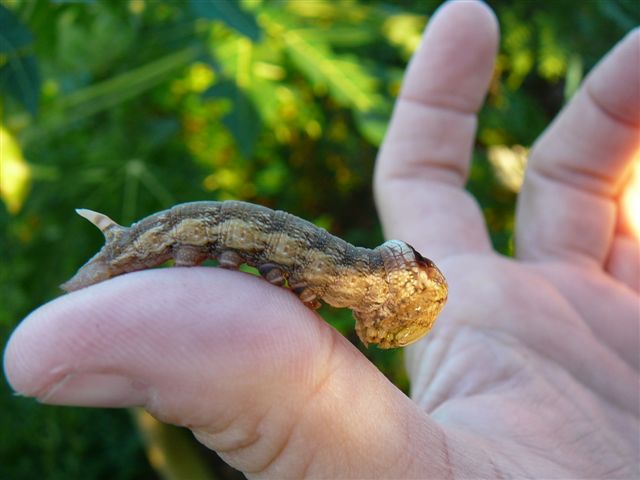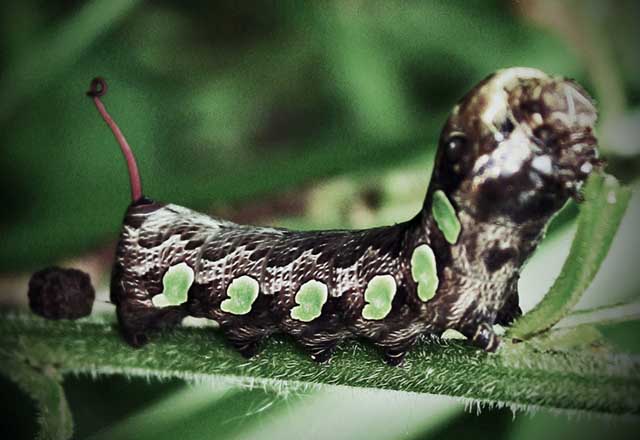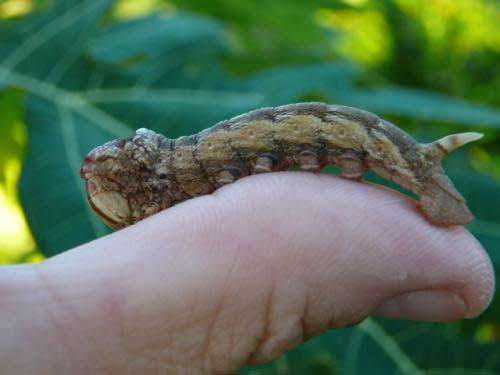Sphinginae subfamily
Sphingini tribe:
 |
Larvae feed on plants in the Convolvulaceae family, especially
Ipomoea batatas (sweet potato) and in the Solanaceae family,
especially (Datura) (jimsonweed) and related plants in the
Americas. There is also a brown form. Look for very large, dark
spiracular circles.
|
 |
Young caterpillars feed gregariously on Catalpa species
(Catalpa bignoniodes and C. speciosa) in the
Bignoniaceae family, skeletonizing the foliage.
Larvae are mostly white in early instars.
generally more eastern species |
 |
Fraxinus, Ligustrum, Quercus, Crataegus and
Chionanthus virginicus are listed as hosts.
In the fifth instar, the spiracular ovals are decidedly red and the
anal horn is off-white to pinkish laterally.
|
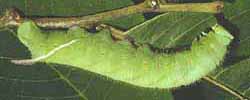
|
Cocytius antaeus,
WO The Giant Sphinx,
Mature caterpillars are very large. In the last instars,
larvae are uniform green with a dark purple center back line and a
very sharp white posterior side slash with some dark green on both
sides of it.
|
 |
Dolba hyloeus
WO, the Pawpaw Sphinx
Larvae feed on pawpaw (Asimina triloba), littleleaf sweetfern
(Myrica aspleniifolia), possum haw (Ilex decidua), and
inkberry (Ilex glabra) as well as Tall Gallberry Holly
(Ilex coriacea).
Louis Handfield reports larvae probably feed on Ilex verticellata
in Quebec.
|

|
Isoparce cupressi
WO, Cypress or Baldcypress Sphinx.
Larvae feed on needles of baldcypress (Taxodium distichum) at night and
pupate in shallow underground burrows where second generation
overwinters.
|
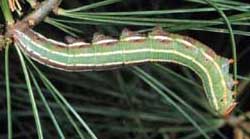 |
Larvae feed upon various pine species, including loblolly pine
(Pinus taeda) and longleaf pine (P. pinaster). They are well
camouflaged and are without an anal horn.
|
jasminearum
 |
The caterpillars are called Tomato Hornworms and each has a black horn at the end of the abdomen.
Larvae feed on potato, tobacco, tomato, and other plants in the
nightshade family (Solanaceae).
|
 |
Manduca rustica
WO, the Rustic Sphinx
The caterpillar has numerous white nodules on top of the thorax and
seven pairs of oblique, blue-gray stripes along the side of the body.
The horn is white at the base and blue-gray at the tip. Many hosts are utilized.
|
 |
Tobacco Hornworms, equipped with a red-tipped horn at the end of the
abdomen, are true gluttons and feed on tobacco and tomato, and
occasionally potato and pepper crops and other plants in the
nightshade family (Solanaceae).
|
 | Preferred hosts are common trumpetcreeper (Campsis radicans),
Florida yellow-trumpet (Tecoma stans), lilac
(Syringa species), and
passionflower (Passiflora species).
The anal horn is blue, preceded by a yellow dash. generally more northerly
|
 |
Larval hosts are apple (Malus), sweetfern (Myrica), Carolina rose
(Rosa carolina), blueberry and huckleberry (Vaccinium), white spruce
(Picea glauca), American larch (Larix laricina), and alder (Alnus). generally more northerly
|
Smerinthini Tribe:
 |
Amorpha juglandis larvae feed upon Walnut and butternut (Juglans),
hickory (Carya), alder (Alnus), beech (Fagus),
hazelnut (Corylus), and hop-hornbeam (Ostrya). generally more northerly
|
 |
Larvae accept willows, birches, and cherries.
I have also found them in the wild on oak in eastern Canada.
The skin is very granulose. generally more northerly
|
 |
The larvae depicted is probably third instar.
There may be more red spotting on the sides
as larvae mature.
|
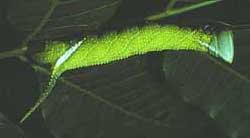 |
Protambulyx strigilis
WO,
the Streaked Sphinx:
In Florida larvae have been found on Schinus terebinthefolia.
Later instars hide at the base of a leaf or near the base of the
tree's trunk when not feeding (all larvae were found on saplings).
Early instar larvae have extremely pointed head capsules and sometimes have difficulty shedding their head capsules.
|
Macroglossinae subfamily
Dilophonotini tribe:
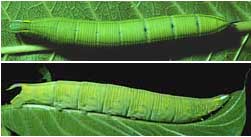
|
Larvae feed on Stemmadenia obovata and probably on other members of the Apocynaceae family.
The narrow, flattened head of the larva is clearly visible in the lateral and dorsal views at left.
|
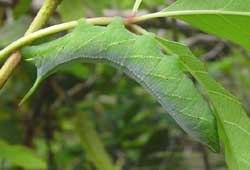
|
The body and wings are dark brown. The forewing has a large black
patch covering most of the outer half of the wing. There is a pale
tan cell spot (dark inner pupil), and a fairly straight median line
to the inside of the cell spot.
|
 |
Erinnyis alope
DMK, the Alope Sphinx.
Larvae have several forms and feed on papaya (Carica papaya),
nettlespurge (Jatropha), and allamanda (Allamanda).
|
Erinnyis alope larva (brown form) on papaya, Port St. Lucie, September 16, 2009, Donna Marie Kisslan.
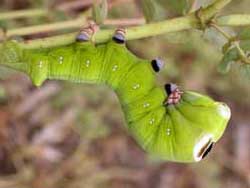 |
Larvae feed on papaya (Carica papaya), Cnidoscolus
angustidens, poinsettia (Euphorbia pulcherrima),
guava (Psidium species) and
saffron plum (Bumelia angustifolia/Bumelia celastrina).
Manilkara bahamensis,
Willow Bustic (Bumelia salicifolia)
and Painted Leaf (Poinsettia heterophylla) are also hosts.
Nice socks! Larvae show considerable variation.
|
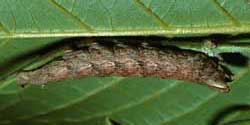 |
Erinnyis obscura, the Obscure Sphinx,
WO.
Larvae feed on Rauvolfia ligustrina, Rauvolfia tetraphylla,
Stemmadenia obovata, Philibertia, Cynanchum, papaya
(Carica papaya), Asclepiadaceae, Blepharodon mucronatum,
White vine (Sarcostemma clausum) and Morrenia odorata.
rare
|
 |
Hemaris thysbe
WO, the Hummingbird Clearwing
There is also an orangey-pink prepupal form. The lateral line runs
from S1 to the blue horn.
Hemaris thysbe larvae feed on viburnum and related plants.
|
 |
Hemaris gracilis
WO?, the
Slender Clearwing or Graceful Clearwing
Larval foods are blueberries including low bush blueberry
(Vaccinium vacillans), and laurel (Kalmia), all in the heath family
(Ericaceae).
|
This species is probably limited to Cuba, being replaced by subspecies floridensis in southern Florida and subspecies
bahamensis in the Bahamas.
In Florida larvae have been found on Black Mangrove (Avicennia germinans), and they are very similar to
the larva of subspecies Madoryx pseudothyreus bahamensis as well as the nominate subspecies.
|
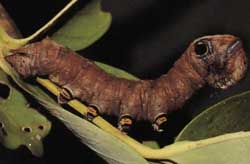 |
Madoryx pseudothyreus floridensis
, the Floridean False-windowed Sphinx.
Females possibly?? lay eggs on evening primrose
(Onagraceae). In southern Florida Madoryx pseudothyreus floridensis larvae have been found on
Black Mangrove (Avicennia germinans). The image to the left is from Florida and represents the subspecies floridensis.
Larvae spin a silken cocoon, affixed to a mangrove branch above ground.
|
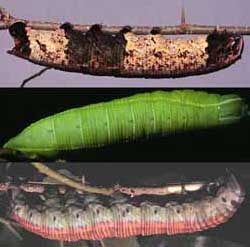 | Females feed and lay eggs on fig leaves, especially Strangler Fig
(Ficus aurea). Ficus carica, Ficus microcarpa, Ficus
religiosa, Ficus pumila, Ficus gamelleira, Ficus prinoides, Ficus
pumila and Artocarpus integrifolia are also listed as
hosts.
The extreme variability of larvae is shown to the left.
The few images that have been sent to me for identification help
are usually as per the upper image.
|
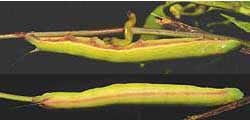 |
Phryxus caicus, the Caicus Sphinx,
WO.
Larvae feed on Mesechites trifida and probably on other
members of the Apocynaceae (Dogbane family: Echites). In Florida
larvae have been reported on mangrove rubber vine (Rhabdadenia
biflora).
Carica papaya serves as a larval host in Brazil.
|
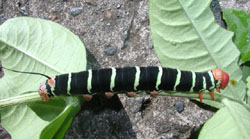 |
Larvae feed on Allamanda cathartica and Frangipani
(Plumieria rubra) and probably other members of the Dogbane
family: Apocynaceae.
The huge, brightly coloured caterpillar is easy to find in gardens.
|
Philampelini tribe:
 |
Larvae feed upon Grape (Vitis), Virginia Creeper
(Parthenocissus quinquefolia) and other vines and ivies
(Ampelopsis).
Larvae occur in both a light (green) form and a darker (tan/brown)
form. Note six "segmented" oblique lines.
|
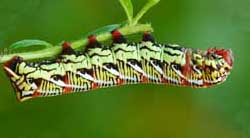 |
Eumorpha fasciatus
WO, the Banded Sphinx
Larvae feed upon primrose-willow, Ludwigia (water primrose)
and other plants in the evening primrose family. This hornless larva is
highly variable. Look for large, dark spiracular circles and a dark
line in the center of the back. See image at bottom of this page.
|
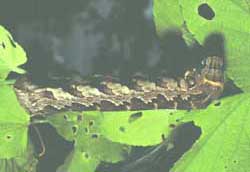 |
Eumorpha labruscae
CS, the Gaudy Sphinx
There is a
striking resemblance to a snake's head and eye, and a flattening of
the thoracic segments when the head is not retracted.
In Florida larvae have been found on Possum Vine
(Cissus sicyoides).
Cissus incisa, Cissus verticillata, Eupatorium odoratum,
Ludwigia,
Magnolia, Parthenocissus and Vitis vinifera are all
reported hosts.
Large "side panels" are green in instars 2-4.
|
Eumorpha labruscae 3-4 instar, Paleo Hammock Preserve, Fort Pierce, June 29, 2013, Chet Smith
 |
If you have Grape or Virginia Creeper nearby, then you might encounter
this species. Note the five large white ovals. There are orangey-brown and green
forms also.
|
Macroglossini tribe:
 |
In additon to Virginia creeper larvae accept Grape (Vitis),
ampelopsis (Ampelopsis), and cayenne pepper (Capsicum).
Larvae are green until the final instar.
|
 |
Larvae feed on Azalea and Viburnum and progress very rapidly. The
larva to the left on Viburnum cassinoides is getting ready to
pupate. Color change from green to light burgundy-brown indicates
pupation is imminent. generally more northerly |
 |
Darapsa myron
WO, the Virginia Creeper Sphinx or the Grapevine Sphinx
If you have the
foodplants indicated in the common names, you probably have this
species nearby. The lower wings are orange.
Larvae feed on Virginia creeper (Parthenocissus quinquefolia),
Grape (Vitis), Ampelopsis, and Viburnum. |
 |
Larvae turn a deep chocolate brown just prior to pupation, and the
"horn" on the tail also turns downward as pupation draws near.
Darapsa versicolor larvae feed on Smooth hydrangea
(Hydrangea arborescens), buttonbush
(Cephalanthus occidentalis), and waterwillow
(Decodon verticillatus).
|
 |
Hyles lineata
WO, the White-lined Sphinx
Larvae are highly varied and feed on a great diversity of plants
including willow weed (Epilobium), four o'clock (Mirabilis),
apple (Malus), evening primrose (Oenothera), elm
(Ulmus), grape (Vitis), tomato (Lycopersicon),
purslane (Portulaca), and Fuschia.
All larvae seem, however, to have the red/black swellings split by
dorso-lateral lines. |
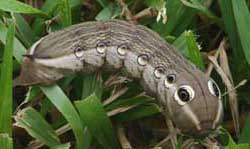 |
Larvae also feed on Borreria, Catalpa and Manettia spp. and
Smooth buttonplant (Spermacoce glabra) and starclusters
(Pentas species). They are also recorded on joe-pie weed and
Hamelia patens and on Hedoydis nigricans. The green form may be more
common.
|
|
|
